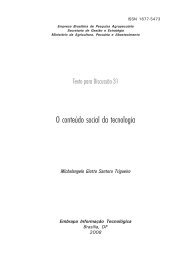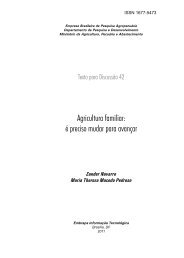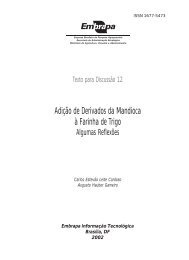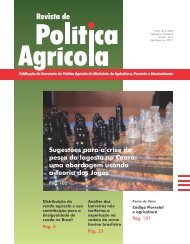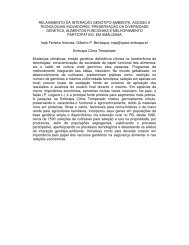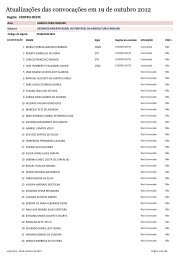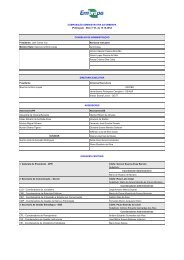Ministry of Agriculture, Livestock and Food Supply - Embrapa
Ministry of Agriculture, Livestock and Food Supply - Embrapa
Ministry of Agriculture, Livestock and Food Supply - Embrapa
Create successful ePaper yourself
Turn your PDF publications into a flip-book with our unique Google optimized e-Paper software.
Energy supply <strong>and</strong> dem<strong>and</strong> scenarios<br />
Figure 6. Evolution<br />
<strong>of</strong> world biodiesel<br />
production.<br />
The Special Report on Emission Scenarios <strong>of</strong> the Intergovernmental<br />
Panel on Climatic Change (IPCC) estimates that the greatest amount <strong>of</strong><br />
renewable energy power in the medium term (2025) will derive from the<br />
development <strong>of</strong> modern biomass (70 to 140 EJ), followed by solar energy<br />
(16-22EJ) <strong>and</strong> wind energy (7-10EJ). The concept <strong>of</strong> modern biomass includes<br />
wood in the form <strong>of</strong> briquettes, carbon <strong>and</strong> black liquor. In the long term, the<br />
contribution <strong>of</strong> the renewable sources is estimated at 1,300 EJ/year, half <strong>of</strong> it<br />
obtained directly from solar energy (2,600 EJ/year).<br />
While the main limitation to the use <strong>of</strong> solar energy is the development <strong>of</strong> a<br />
technology that makes obtaining <strong>and</strong> storing solar energy economically feasible,<br />
it is believed that in the case <strong>of</strong> agricultural energy there would be a maximum<br />
expansion limit because <strong>of</strong> the competition <strong>of</strong> food production for l<strong>and</strong>.<br />
Consequently, it is important to achieve productivity gains not only in food <strong>and</strong><br />
fiber agriculture, but also in energy agriculture, so that the dispute over l<strong>and</strong> may<br />
be delayed until other renewable sources <strong>of</strong> energy have become viable.<br />
The International Institute for Applied Systems Analysis <strong>and</strong> the World<br />
Energy Council have jointly drawn scenarios for the 21st century (Table 6).<br />
Their projections show that only scenarios that include the replacement <strong>of</strong><br />
fossil sources <strong>of</strong> energy with renewable energy (scenarios A3, C1 <strong>and</strong> C2)<br />
could promote sustainable development with low environmental impact (local<br />
<strong>and</strong> global) <strong>and</strong> a more equitable distribution <strong>of</strong> resources <strong>and</strong> wealth. To the<br />
contrary, a projection <strong>of</strong> the current situation <strong>and</strong> trends would not to lead to<br />
sustainability even with technological advances <strong>and</strong> moderate economic<br />
growth (scenario B).



